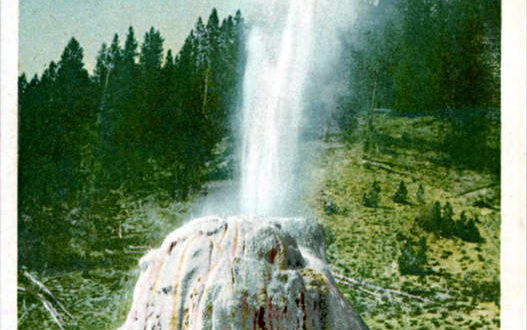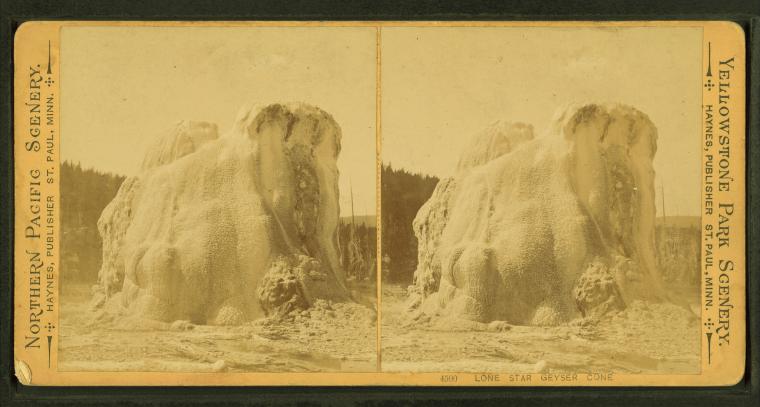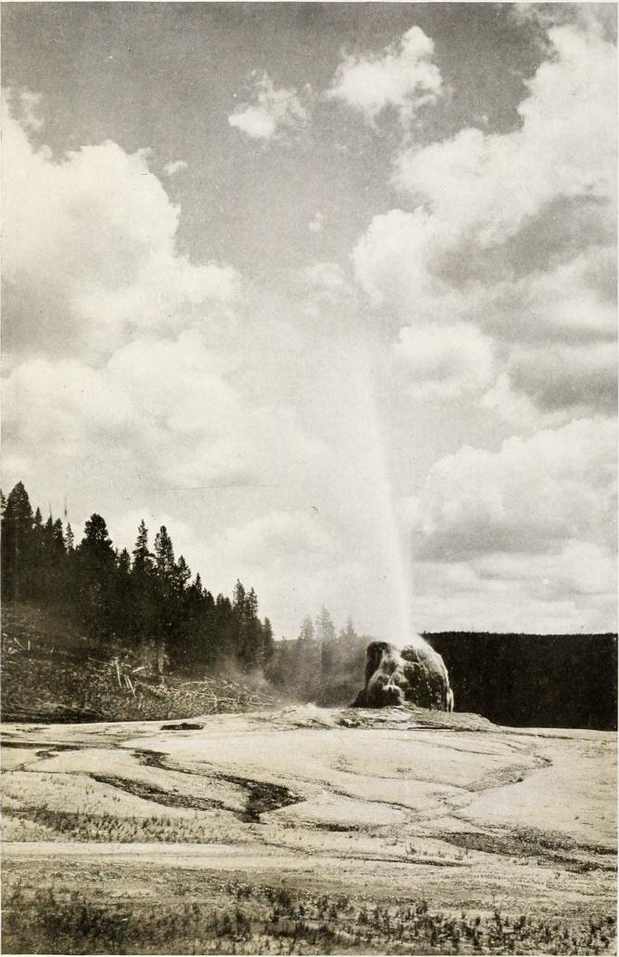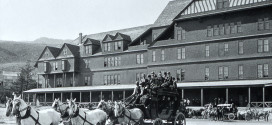Although it’s one of the most popular thermal features in Yellowstone National Park, the origins of Lone Star Geyser are somewhat obscure.
I should clarify. In terms of its geologic structure, Lone Star Geyser’s origins are straightforward. Distinguished by its magnificent eruptions and its resplendent cone, Lone Star is the product of thousands of years of mineral accumulation, as boiling water carries dissolved material, depositing layer upon layer.
In a certain sense, its name is the product of accumulation as well. Indeed, Lone Star Geyser has had several names over the years since its discovery in the early 1870s.
First Incarnation
The Hayden Geological Survey names this feature “Solitary Geyser” during their 1872 trip. According to historian Lee H. Whittlesey, writing in Yellowstone Place Names, survey member Frank Bradley described the cone as having ”a fine profile of a mild-featured human face done in the bead-work.”
The name “Solitary Geyser” fell out of favor in the 1880s, however, according to Aubrey L. Haines in Yellowstone Place Names: Mirrors of History. In 1882, Frank Jay Haynes started selling stereographs of the feature with the “Lone Star” name (one of which you can see below), which stuck far more than they Hayden-sanctioned “Solitary.”
Today, Solitary Geyser is the name of a feature in the Upper Geyser Basin, found in the Lion Group.
Origins
According to Haines, there are two accounts as to the origins of the name “Lone Star.” Neither story conflicts with each other, per se; indeed, Haines offers as a sort of conciliation: if you want to know which version is the true version, “it depends on whose story you like best.” From Mirrors of History:
As the rails of the Northern Pacific main line approached Benson’s Landing on the Yellowstone River in the summer of 1882, a party including two civil engineers, Carl A. Hals and A. Rydstrom, ran an exploratory survey across the Park to determine the practicability of extending a branch line into or through the area. Three miles south of Old Faithful, as they were running their line up the Firehole River, they came upon a remarkable geyser cone in a small opening in the forest. S.P. Panton, who was a member of that party, says they assumed they were its discoverers, “so we named it ‘Lone Star Geyser’ on our profiles.
The other story is attributed to a Mr. J.M.V. Cochran, an eighty-four-year-old resident of Oak Grove, Oregon. He wrote:
To the best of my recollection it was in 1874 when I was out with Co. W.D. Pickett of Louisville, Kentucky, on a hunting trip. We were camped near Old Faithful Geyser. I went out hunting for bear and was on a high butte over-looking the basin when I saw the steam from a geyser above the trees and went down to it. There were game trails near but no blazed trails nor trails showing signs of having been traveled by horses, nor any signs of old campfire — in fact, nothing to show that anyone had ever been there before.
The next day I returned with Col. Pickett and took with me a board off a cracker box and nailed it up on a tree and printed on it the name “Lone Star Geyser.”
On this trip we did not see anyone in either the upper or lower basins but on the way out met Mr. Calfee and Mr. Catlan [sic] near Sulphur Mountain. They were on their way into the basins to take pictures of the geysers. I told them about the Lone Star Geyser and gave them directions how to find it from Old Faithful Geyser. If they took views, as they intended, they would be the first ever taken of Lone Star Geyser.
Disconnect
According to Haines, although the Cochran account antecedes both Haynes and the NPRR’s account, its chronology is somewhat murky:
Cochran’s presence in the Park with Col. Pickett is confirmed by the latter’s book, Hunting At High Altitudes — but the year was 1879, not 1874 (hunting was allowed in Yellowstone until 1883). Although Henry Bird Calfee did enter Yellowstone Park as early as the summer of 1873, the period from 1877 to 1881 corresponds with his photographic activity there. Calfee’s work as known today does not include a photograph of Lone Star Geyser.
We can back up Haines’ assertion vis-à-vis Calfee and Lone Star Geyser. According to Yellowstone Stereoviews, Lone Star Geyser does not appear in any of the officials series from either “Calfee & Catlin” or “H.B. Calfee,” although it was a popular subject with other publishers.
As far as the two stories, it would be fair to say Cochran can claim bragging rights for naming it Lone Star first—but Haynes gets more credit for popularizing it.
 Yellowstone Insider Your Complete Guide to America's First National Park
Yellowstone Insider Your Complete Guide to America's First National Park








You must be logged in to post a comment.